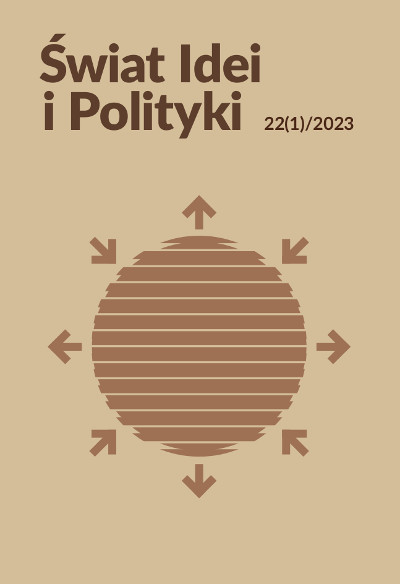An interrupted life. Children in the narrative line of exhibition at the Estonian Jewish Museum
DOI:
https://doi.org/10.34767/SIIP.2023.01.05Keywords:
Holocaust, war, museum, children, Estonia, TallinAbstract
The author analyzes the permanent exhibition of the Estonian Jewish Museum (Eesti Juudi Muuseum). Using the methods of visual studies (composition, content, material objects, and meanings), he tries to find out the place of the youngest victims of the Holocaust in the narrative line of the exhibition. He asks whether there are separate elements of the permanent exhibition devoted to them, or whether the children’s fates are “inscribed” in the general message about the events documented there. Do the museum’s creators focus on the tragic dimension of the children’s fates or do they present them through the prism of heroic deeds, showing the individuals who performed them? And finally, is there a place to present the survivors? The research, the results of which are presented in the paper, also aims to answer the question of whether the narrative line of the museum is dedicated to specific individuals or to a community of anonymous participants of war events. The research shows that the Holocaust story presented at the Estonian Jewish Museum focuses on the loss and suffering that resulted in interrupted lives. The perspective of the victims dominates the analyzed exhibitions. Civilian victims of occupation and genocide are at the center of the exhibition. They are not ‘heroic victims’, i.e. heroes who achieve a moral victory by dying in the fight for freedom or honor. It is death that becomes the key category present in the exhibition, even if it is not always expressed.
References
Banks, M. (2009). Materiały wizualne w badaniach jakościowych. Warszawa: Wydawnictwo Naukowe PWN.
Chwedoruk, R. (2018). Polityka historyczna. Warszawa: Wydawnictwo Naukowe PWN.
De Jong, S. (2013). Im Spiegel der Geschichten. Objekte und Zeitzeugenvideos in Museen des Holocaust und des Zweiten Weltkrieges. WerkstattGeschichte, 62.
Erll, A. (2018). Kultura pamięci. Wprowadzenie. Warszawa: Wydawnictwa Uniwersytetu Warszawskiego.
Goffman, E. (2012). Ramy fotografii. W: M. Bogunia-Borowska & P. Sztompka (red.), Fotospołeczeństwo. Antologia tekstów z socjologii wizualnej (s. 265–304). Kraków: Wydawnictwo Znak.
Katz, J. (2012). Stamped „Judenfrei”: The Holocaust on the territory of Nazi-occupied Estonia 1941–1944. Tallin: Jewish Community of Estonia.
Katz, J. (2016). The Jewish Community of Estonia: Revival Experience. Tallin: Jewish Community of Estonia.
Kącka, K. (2015). Polityka historyczna: kreatorzy, narzędzia, mechanizmy działania – przykład Polski. W: K. Kącka, J. Piechowiak-Lamparska & A. Ratke-Majewska (red.), Narracje pamięci: między polityką a historią (s. 59–80). Toruń: Wydawnictwo Naukowe UMK.
Kudela-Świątek, W. & Saryusz-Wolska, M. (2014). Zmysły. W: M. Saryusz-Wolska & R. Traba (red.), Modi memorandi. Leksykon kultury pamięci (s. 554–556). Warszawa: Wydawnictwo Naukowe Scholar.
Laar, M. (2017). Estonia in World War II. Tallin: Grenader.
Landsberg, A. (2018). Ameryka, Holokaust i masowa kultura pamięci. W stronę radykalnej polityki empatii. W: P. Majewski & M. Napiórkowski (red.), Antropologia pamięci. Zagadnienia i wybór tekstów (s. 165–172). Warszawa: Wydawnictwa Uniwersytetu Warszawskiego.
Oztig, L.I. (2022). Holocaust museums, Holocaust memorial culture, and individuals: a Constructivist perspective. Journal of Modern Jewish Studies, 22(1), 1–22. DOI: 10.1080/14725886.2021.2011607.
Pomian, K. (2023). Muzeum. Historia światowa. 1. Od skarbca do muzeum. Gdańsk: Wydawnictwo Słowo/Obraz Terytoria, Fundacja Terytoria Książki.
Ptak, P. (2014). Przekaz historyczny i jego narracja w miejscach pamięci. W: P. Trojański (red.), Auschwitz i Holokaust. Edukacja w szkole i w miejscu pamięci (s. 311–315). Oświęcim: Państwowe Muzeum Auschwitz-Birkenau.
Rose, G. (2010). Interpretacja materiałów wizualnych. Krytyczna metodologia badań nad wizualnością. Warszawa: Wydawnictwo Naukowe PWN.
Snyder, T. (2015). Czarna ziemia. Holokaust jako ostrzeżenie. Kraków: Znak Horyzont.
Sontag, S. (2017). O fotografii. Kraków: Wydawnictwo Karakter.
Stocker, P.O. (2016). Holocaust Memory in Contemporary Estonia. Clashes of Victimhood. Baltic Worlds, 1–2, 16–25.
Sztyma, T. (2019). Muzea żydowskie w Europie – geneza i charakterystyka. Muzealnictwo, 60, 55–63. DOI: 10.5604/01.3001.0013.2023.
Taylor, N. (2018). Estonia. A Modern History. London: Hurst&Company.
Ubertowska, A. (2007). Świadectwo – trauma – głos. Literackie reprezentacje Holokaustu. Kraków: Universitas.
Weiss-Wendt, A. (2008). Why the Holocaust does not matter to Estonians. Journal of Baltic Studiesi, 39, 4, 475–497.
Weiss-Wendt, A. (2013). Victim of History: Perceptions of the Holocaust in Estonia. W: J.-P. Himka & B. Michlic (red.), Bringing the Dark Past to Light: The Reception of the Holocaust in Postcommunist Europe. Lincoln – London: University of Nebraska Press.
Winstone, M. (2017). Miejsca Holocaustu w Europie. Warszawa: Bellona.
Ziębińska-Witek, A. (2014). Muzeum. W: M. Saryusz-Wolska & R. Traba (red.), Modi memorandi. Leksykon kultury pamięci (s. 246–251). Warszawa: Wydawnictwo Naukowe Scholar.
Ziębińska-Witek, A. (2020). Przeszłość w muzeach. Dwa modele reprezentacji. Analiza porównawcza Europejskiego Centrum Solidarności i Muzeum II Wojny Światowej w Gdańsku. Teksty Drugie. Teoria Literatury, krytyka, interpretacja, 4, 213–232. DOI: 10.18318/td.2020.4.12.


